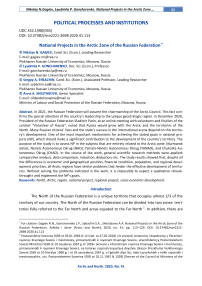National projects in the Arctic zone of the Russian Federation
Автор: Gagiev Nikolay N., Goncharenko Lyudmila P., Sybachin Sergey A., Shestakova Anna A.
Журнал: Arctic and North @arctic-and-north
Рубрика: Political processes and institutions
Статья в выпуске: 41, 2020 года.
Бесплатный доступ
In 2021, the Russian Federation will assume the chairmanship of the Arctic Council. This fact confirms the special attention of the country’s leadership to the unique geostrategic region. In December 2020, President of the Russian Federation Vladimir Putin, at an online meeting with volunteers and finalists of the contest “Volunteer of Russia”, noted that Russia would grow with the Arctic and the territories of the North. Many Russian citizens’ lives and the state’s success in the international arena depend on this territory’s development. One of the most important mechanisms for achieving the stated goals is national projects (NP), which should make a significant contribution to the development of the country’s territory. The purpose of the study is to assess NP in the subjects that are entirely related to the Arctic zone: Murmansk region, Nenets Autonomous okrug (NAO), Yamalo-Nenets Autonomous okrug (YANAO), and Chukotka Autonomous okrug (CHAO). In the course of the work, general scientific research methods were applied: comparative analysis, data comparison, induction, deduction, etc. The study results showed that, despite all the differences in economic and geographical position, financial condition, population, and regional development priorities, all Arctic regions have similar problems that hinder the effective development of territories. Without solving the problems indicated in the work, it is impossible to expect a qualitative «breakthrough» and implement the NP’s goals.
North, arctic, region, national project, regional project, socio-economic development
Короткий адрес: https://sciup.org/148318364
IDR: 148318364 | УДК: 332.1(98)(045) | DOI: 10.37482/issn2221-2698.2020.41.113
Текст научной статьи National projects in the Arctic zone of the Russian Federation
The North of the Russian Federation is a unique territory that occupies almost 2/3 of the territory of our country. The North of the Russian Federation can be divided into two zones: territories fully referred to the Far North and areas equated to the Far North 1. In addition, there are
the Arctic territories in the North zone, which are separately distinguished and include the territories of the Yamalo-Nenets, Nenets and Chukotka Autonomous Districts, the Murmansk Oblast, and also partially the territories of the following subjects: the Republic of Komi (Vorkuta urban district (hereinafter — UD)); seven municipal districts of the Arkhangelsk oblast, including the Arkhangelsk UD; Krasnoyarsk Territory (Norilsk UD, Taimyr Dolgan-Nenets and Turukhansk districts); Republic of Sakha (Yakutia) (13 uluses (districts)); lands and islands located in the Arctic Ocean specified in the Decree of the Presidium of the Central Executive Committee of the USSR of April 15, 1926 and other acts of the USSR2. 2.431.518 people live In the Arctic zone of the Russian Federation (AZRF), as of 01.01.20203, which is approximately 1.65% of the country's population. The area of the Russian Arctic is slightly more than 3 million km² (18% of the entire territory of the country), while it provides over 11% of the country's total national income. Fig. 1 shows the division of the territories of the Russian Federation into zones of the North and the Arctic.
The aim of this study is to assess NP in four regions fully referred to the Arctic zone of the Russian Federation. To achieve this goal, the following tasks should be solved: to assess the structure of NP in the specified entities; identify the most pressing problems that hinder the achievement of the goals set in the NP and propose recommendations for solving the selected problems.
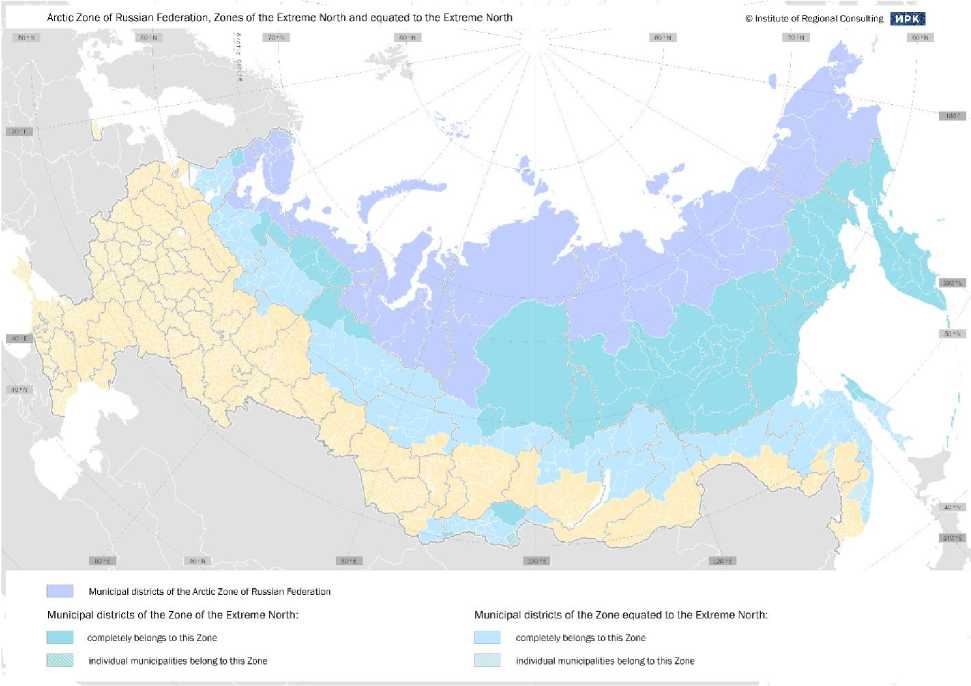
Fig. 1. The boundaries of the Arctic zone of the Russian Federation and the boundaries of the Far North regions and equivalent localities 4.
Legal regulation of the Russian Arctic
The development of the Arctic zone of the Russian Federation is governed by various regulatory legal acts now. Consider the main stages of the formation and development of the regulatory framework governing this territory.
In the Order of the Government of the Russian Federation of November 17, 2008 N 1662-r (as revised on September 28, 2018)5 in section 7, there was the first mention of the need to intensify the development of the Russian sector of the Arctic through the further development of fields, including on the Arctic shelf, the development of port facilities, development of the Northern Sea Route, reduction of environmental damage, development of modern technologies. In the next 10 years, there have been no changes in the Concept, except the appearance of JSC «DOM.RF».
On September 18, 2008, the Arctic zone of the Russian Federation was legally defined, the “Fundamentals of the state policy of the Russian Federation in the Arctic up to 2020 and further perspective” 6 (invalid) was approved — a fundamental document adopted by the President of the Russian Federation, regulating activities in the AZRF. In March 2020, in accordance with the Decree of the President of the Russian Federation dated 05.03.2020 N 1647, the national interests of Russia in the Arctic were expanded and clarified, the main threats and challenges to national security in this zone were identified, new tasks were formed in various areas of the Arctic zone and, which is extremely important, the main indicators of the effectiveness of the implementation of state policy in the Arctic up to 2035 have been determined.
In February 2013, pursuant to the above-mentioned State Policy Bases, the Strategy for the Development of the Arctic Zone of the Russian Federation and Ensuring National Security for the period up to 2020 was adopted 8. This document determined the main mechanisms, methods and means of achieving strategic goals and priorities for the development of the Arctic and ensuring its national security. The main mechanism for the implementation of this Strategy was the State Program “Socio-economic development of the Arctic zone of the Russian Federation for the period up to 2020” (invalid), adopted in 2014, which was subsequently updated and adjusted in 2014, 2017, 2019 and 2020 9.
The list of land areas of the Russian Arctic appeared in May 2014 after the signing of the Decree by the President of Russia dated 02.05.2014 No. 296 10. Subsequently, the list was expand- ed to include three municipal districts of the Republic of Karelia in 2017, and in 2019 the number of uluses (districts) of the Republic of Sakha (Yakutia) increased to thirteen.
On May 7, 2020, the Ministry of the Russian Federation for the Development of the Far East and the Arctic submitted a draft of “Strategy for the Development of the Arctic Zone of the Russian Federation and Ensuring National Security for the Period up to 2035” to the Government of the Russian Federation. The document was developed in order to fulfill “The Fundamentals of State Policy of the Russian Federation in the Arctic for the period up to 2035” 11. At the moment, the document has been adopted by the Government of the Russian Federation and is being signed by the President. In addition to this project, in August 2020, the Republic of Sakha (Yakutia) adopted its own “Strategy for the socio-economic development of the Arctic zone of the Republic of Sakha (Yakutia) for the period up to 2035”12. This Strategy became the first independent document of the Arctic region. This document could then form the basis for creating their own strategies by the rest of the regions included in the Russian Arctic. The Strategy is based on the comprehensive development of infrastructure, the creation of support centers in the Arctic zone of the region, and an increase in the quality and standard of living of the population.
As part of the study of future legislation governing the development of the Arctic zone, it is worth mentioning the draft Decree of the Government of the Russian Federation, specifying the “List of regions of the Far North and localities equated to the regions of the Far North, for the purpose of providing state guarantees and compensation for people working and living in these areas and localities”13. In this project, in addition to clarifying the list of regions, the currently valid Resolutions of the Council of Ministers of the USSR of November 10, 1967 No. 1029 “On the procedure for applying the Decree of the Presidium of the Supreme Soviet of the USSR”, of September 26, 1967 “On the expansion of benefits for persons working in the regions of the Far North and in are- as equated to the regions of the Far North” 14 and the Resolution of the Council of Ministers of the USSR of January 3, 1983 No. 12 “On amendments and additions to the List of regions of the Far North and localities equated to the regions of the Far North, approved by the Council Resolution of the USSR Ministers of November 10, 1967 No. 1029” 15 will be repealed. The adoption of this decree will make it possible to systematize and generalize the list of these regions, to make changes to outdated regulations governing the issues of state guarantees and compensations to people living in the North.
In addition, in July 2020, the Federal Law No. 193 16 was adopted, which will take effect from 28.08.2020. According to article 2 paragraph 3 of this law, the Arctic territories will additionally include the municipal district (MD) “Kaleval National Municipal District”, “Kostomuksha Urban District” MD, “Segezha Municipal District” of the Republic of Karelia, “Inta” MD UD, “Usinsk” MD UD, “Ust-Tsilemskiy” MD of the Komi Republic, 10 rural settlements of the Krasnoyarsk Territory, “Leshukonsky Municipal District” and “Pinezhsky Municipal District” of the Arkhangelsk Oblast.
Analysis of the implementation of national projects in the AZRF
In 2018, the President of the Russian Federation Putin V.V. signed Decree No. 204 “On national goals and strategic objectives for the development of the Russian Federation for the period up to 2024” 17. To achieve the goals set in the Decree by the end of 2024, the Government has de- veloped 12 national projects (NP) and 1 comprehensive plan for the modernization and expansion of the trunk infrastructure, their total cost should be almost 26 trillion rubles. It should be noted that in connection with the coronavirus pandemic, the reduction in budget revenues, the insufficient achievement of targets, and the change in priorities, Presidential Decree No. 474 was signed in July 2020 18, according to which the Government of the Russian Federation will have to adjust the NP and develop a unified plan to achieve the country's national development goals for the period up to 2024 and for the planned period up to 2030 by October 30, 2020.
In order to assess the progress of the NP implementation in the subjects of the Russian Arctic, let us turn directly to the analysis of the NP implementation in the Murmansk oblast, Nenets, Yamalo-Nenets and Chukotka Autonomous Okrugs.
On the basis of the NP, each constituent entity of the Russian Federation forms its own regional projects, taking into account the tasks assigned to it and the available funding. Table 1 shows a comparative characteristic of regional projects and the amount of financial support provided for 2020. Undoubtedly, the comparison in terms of the level of funding is incorrect, considering the financial capabilities of the regions, the established targets and tasks in regional projects, the population size, the area of the territory, the economic and geographical location, but nevertheless, the difference between the amount of funds allocated for the implementation of NP in the Chukotka Autonomous District and the Yamalo-Nenets Autonomous District is significant — more than 30 times, and between the Murmansk Oblast and the Yamalo-Nenets Autonomous District — almost 3 times.
Table 1
Number of regional projects implemented in the subjects of the Russian Arctic within the framework of national projects 19
National project Murmansk oblast NAO YaNAO ChAO Demographics 5 5 5 5 Healthcare 7 6 7 7 Education 8 7 7 7 Culture 3 3 3 2 Housing and urban environment 3 3 3 3 Ecology 6 5 3 4 Safe and high-quality roads 3 3 3 3 velopment of the Russian Federation for the Period Up to 2024"]. URL: (accessed 03 May 2020).
18 Ukaz Prezidenta Rossiyskoy Federatsii ot 21.07.2020 N 474 «O natsional'nykh tselyakh razvitiya Rossiyskoy Feder-atsii na period do 2030 goda» [Decree of the President of the Russian Federation of July 21, 2020 No. 474 "On the National Development Goals of the Russian Federation for the Period Up to 2030"]. URL: (accessed 03 May 2020).
19 Official website of the Government of the Murmansk region. URL: (accessed 03 August 2020); Official website of the Government of the Nenets Autonomous Okrug. URL: (accessed 03 August 2020); Official website of the Government of the Yamalo-Nenets Autonomous Okrug. URL: (accessed 03 August 2020); Official website of the Government of the Chukotka Autonomous Okrug. URL: (accessed 03 August 2020).
|
Labor productivity and supporting employment |
- |
3 |
2 |
- |
|
Science |
- |
- |
- |
- |
|
Digital economy |
5 |
5 |
5 |
5 |
|
Small and medium businesses and support for business initiatives |
5 |
5 |
5 |
5 |
|
International cooperation and export |
4 |
2 |
2 |
3 |
|
The amount of financial support for the implementation of the NP in 2020 (million rubles)20 |
14 574.77 |
3 584.54 |
43 370.63 |
1 414.54 |
|
Total regional projects |
49 |
47 |
45 |
44 |
Let us turn to the volume of funding for regional projects of the Arctic entities in order to identify the most significant and priority projects for each of the regions. Figures 2–5 show the amount of funding for each NP where the entity participates. The presented data may differ from the data in the passports of regional projects, since the amount of funding for NP is specified and adjusted several times a year, depending on the current financial and economic situation and due to discrepancies in the data provided by the subjects to the federal center. Let's single out those projects in which the planned amount of funding for 2019–2024 exceeds 10 billion rubles. At the same time, it should be noted that the indicated amounts of funding include both funds from the federal budget and from the district one.
In the Yamalo-Nenets Autonomous District (Fig. 2), the largest amount of funding was received by NP “Housing and Urban Environment” (over 59 billion rubles), “Demography” (over 46), “Health care” (over 44), “Education” (over 35), “Safe and high-quality roads” (over 20). It should be noted that out of the 215.6 billion rubles intended for realization of all NP in the district in 2019–2024, only 5.2 billion rubles is directed from the federal budget (approximately 2.4%), the rest of the funds are sought by the region on its own or brought by extra-budgetary sources. The most “expensive” regional projects of the district (over 10 billion rubles) are “Modern School” (31.4 billion rubles), “Ensuring a sustainable reduction in the housing stock unsuitable for habitation” (27.5), “Housing (Digital culture)”(22.4),”Promoting the employment of women — creating conditions for preschool education for children under three years old”(20.1), “Road net-work”(19.9),”Financial support for families at the birth of children”(17.9), “Control of oncological diseases” (17.1) and “Development of the primary health care system” (13.7). Thus, it can be noted that the priority areas of development in the subject are the construction of new schools and the renewal of the material base of the existing ones, the reduction of the share of dilapidated and unsafe housing and the resettlement of citizens living there, the provision of employment opportunities for women with children, including advanced training and retraining, increasing the availability of preschool education, increasing the birth rate, building new and modernizing exist- ing roads, as well as early detection of malignant neoplasms, improving the quality and level of medical care.
In the Murmansk oblast (Fig. 3), the social orientation of the NP is singled out: the largest funding will be received by “Health care” (over 21 billion rubles), “Demography” (over 17) and “Housing and Urban Environment” (over 10). The most important regional project is “Control of oncological diseases” (14.5 billion rubles). The increased attention to this problem is not accidental: in the period from 2015–2019, the number of deaths due to neoplasms per 100 thousand people increased from 188.2 to 203.2 (an increase of 8%) and is the second cause of death in the region21.
In the Nenets Autonomous District (Fig. 4), the most important and the only NP with the funding exceeding 10 billion rubles, is “Safe and High-Quality Roads” — 12.6 billion rubles, 12.3 billion rubles of this amount are allocated to the regional project “Road Network”. The two main goals set in this project are to increase the share of the length of regional and intermunicipal highways to 81.5% that meet regulatory requirements, as well as to bring the share of the length of the road network of the Nar'jan-Mar urban agglomeration to 90.3% corresponding to regulatory requirements. The smaller, in comparison with other subjects, amount of funds allocated for other NP is explained by the small population of the region: as of 01.01.2020, its number was 44.111 people.
In Chukotka Autonomous Okrug (Fig. 5) there is not a single NP for which more than 10 billion rubles would be allocated. The most financially secured are “Demography” (over 4 billion rubles) and “Health care” (3.3) NP. The main goal of the region is to “keep” the population, increase its number and improve the quality of medical care, especially in hard-to-reach and remote areas.
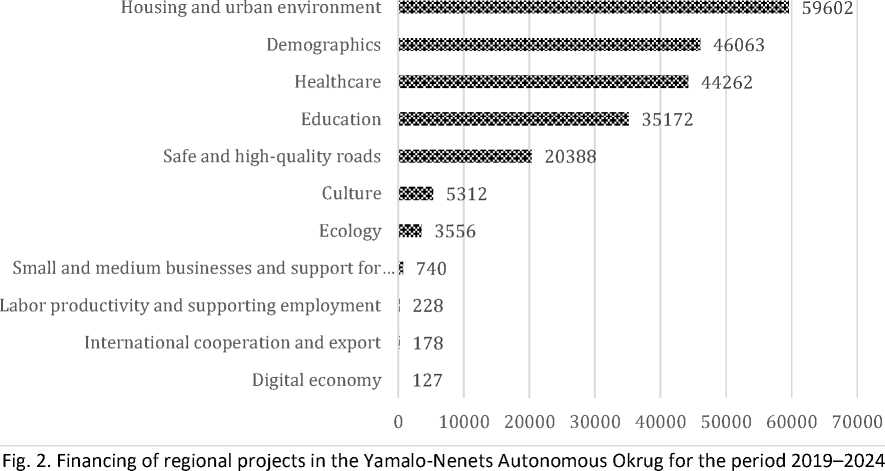
, million rubles22.
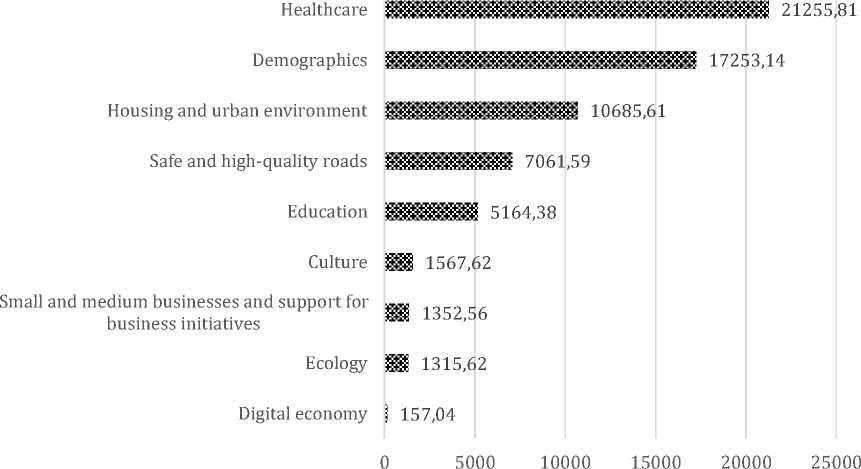
Fig. 3. Financing of regional projects in Murmansk oblast for the period 2019–2024, million rubles 23.
-
22 Regional'nye proekty Yamalo-Nenetskogo avtonomnogo okruga po sostoyaniyu na 01.02.2020 g. Infografika [Regional Projects of the Yamalo-Nenets Autonomous Okrug as of 01 February 2020. Infographics]. URL: https://www.yanao.ru/documents/all/projects/70899/ (accessed 06 August 2020).
-
23 Edinyy portal byudzhetnoy sistemy Rossiyskoy Federatsii. Zaplanirovannye rezul'taty realizatsii regional'nykh proektov [Unified portal of the budgetary system of the Russian Federation. Planned results of the implementation of regional projects]. URL: budg-
et.gov.ru/epbs/faces/p/Национальные%20проекты/Перечень%20региональных%20проектов/Результаты%20рег иональных%20проектов?_adf.ctrl-state=orn4bujnk_109®ionId=44 (accessed 06 August 2020).
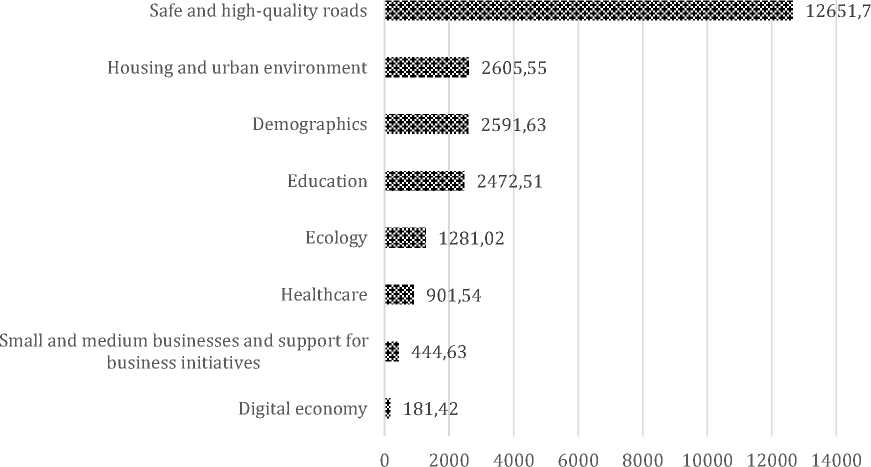
Fig. 4. Financing of regional projects in the Nenets Autonomous Okrug for the period 2019–2024, million rubles 24
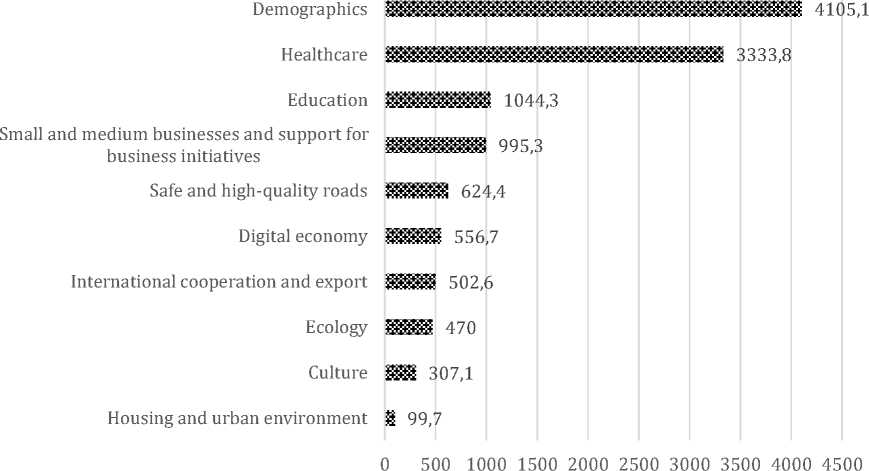
Fig. 5. Financing of regional projects in the Chukotka Autonomous Okrug for the period 2019–2024, million rubles 25
-
24 Edinyy portal byudzhetnoy sistemy Rossiyskoy Federatsii. Zaplanirovannye rezul'taty realizatsii regional'nykh proektov [Unified portal of the budgetary system of the Russian Federation. Planned results of the implementation of regional projects]. URL: budg-
budg-et.gov.ru/epbs/faces/p/Национальные%20проекты/Перечень%20региональных%20проектов/Результаты%20рег иональных%20проектов?_adf.ctrl-state=orn4bujnk_109®ionId=44 (accessed 06 August 2020).
-
25 Strategicheskoe razvitie i realizatsiya natsional'nykh proektov Chukotskogo avtonomnogo okruga [Strategic Development and Implementation of National Projects of the Chukotka Autonomous Okrug]. URL: https://go-pevek.ru/меню/полезная-информация/стратегическое-развитие-и-реализация-национальных-проектов-чукотского-автономного-округа (accessed 06 August 2020).
The main problems hindering the implementation of national projects in the AZRF
The Russian Arctic zone is the most important strategic national priority of our country [1, Korchak E.A., p. 8; 2, Romashkina G.F., Didenko N.I., Skripnuk D.F., p. 29], characterized by a number of problems and difficulties that hinder its effective development and use of the existing potential. In the framework of the forum "Arctic: Territory of Dialogue"26 held in April 2019, the key problems faced by the Arctic regions in the implementation of national projects were raised. Let us highlight the most critical of them, which, in our opinion, can negatively affect the achievement of the goals and objectives of the NP.
-
1. Low life expectancy in all regions, except for the YaNAD. Life expectancy in 2019 was 73.34 years on average in the country, while in the Murmansk oblast it was 71.75 years 27, in the NAD — 73.19 years 28, in the Yamalo-Nenets Autonomous District — 74.2 years 29, in the ChAD — 68.09 years 30, at the same time, the average healthy life expectancy in the country was 60.3 years, in the Murmansk oblast it was 59.4 years, in the NAD — 55.7 years, in the YaNAD — 56.5 years, in the ChAD — 49.1 years31. This situation cannot be explained, for example, by the general mortality rate of the population: in 2019, the natural increase (decrease) per 1.000 inhabitants in the Murmansk oblast was –2.4, in the NAD it was +4.7, in the Yamalo-Nenets Autonomous District it was +7.9, in the ChAD it was +1.4 (on average in Russia: –2.2). As noted at this forum, the main reason for the low life expectancy is the high mortality rate in the working age that is ahead of the average Russian indicators, for example, in the ChAD it is 1.7 times higher. To change the current situation, it is necessary to improve the quality of medical care provided by modernizing medical
-
2. High migration outflow of the population. Over the last five years, the migration decline in the Murmansk oblast amounted to 21.5 thousand inhabitants since 2015, in the NAD — to 700 inhabitants, in the YaNAD — to 20.9 thousand inhabitants, in the ChAD — to 970 inhabitants 32. As it can be seen, there is no positive migration growth in any entity. The dynamics over the past two years shows, that there has been an increase in the migration outflow in the Murmansk oblast, in the NAD there was a slight positive migration increase in 2019, in the YaNAD there is a downward trend in negative migration rates, in the ChAD positive migration population growth is recorded in 2018–2019. The situation is worsened by the fact that a distinctive feature of the migration is the outflow of inhabitants not only older than the working age, but also the young, working-age population [3, Kryukova V.A., Skufina T.P., Korchak E.A., p. 183].
-
3. Low rates of housing commissioning, a high proportion of dilapidated, substandard housing. Harsh climatic conditions, difficulty in logistics supplies, high construction costs have a direct impact on the provision of housing to the population.
-
4. Transport problem. The AZRF is heterogeneous in terms of the level of development of transport infrastructure, the regions “... are practically not equipped in transport terms and practically do not have full-fledged connections with the backbone transport network and established intra-district communications” [10, Serova N.A., p. 95]. If in its western part the transport “connectivity” of territories with the rest of the country is quite well developed, then in the east all communications are provided at the expense of the Northern Sea Route, air communication and
equipment, improving the qualifications of doctors, increasing wages and wider use of telemedicine in remote areas. State programs, for example, “Zemskiy Doctor”, should be more actively disseminated in the Arctic regions, including through the provision of additional benefits and preferences to medical workers, for example: provision of housing, additional payments for work in the regions of the Arctic zone, expansion of the social package.
The outflow of the working-age population is facilitated by many problems in the social sphere. For example, it is noted that “... due to the specific features (functional specifics of the Arctic settlements), a significant territorial differentiation of unemployment remains” [4, Korchak E.A., p. 134] in the Arctic regions, a shortage of jobs. A significant pressure on business, increased social obligations lead to the fact that small and medium-sized businesses do not “... have any significant impact on the economic aspects of the development of the Arctic territories” [5, Tutygin A.G., Chizhova L.A., Regeta A .I., p. 49], that is, the state and big business remain the only “driving forces” of regional development. This situation has developed, in our opinion, due to the fact that it is much more profitable for employers to recruit workers on a rotational basis from outside the Arctic regions. Here it is necessary to agree with the opinion of Pilyasov A.N. and Putilova E.S. that the further development of the Arctic territories does not imply the creation of a large number of new jobs and leads to a lack of social obligations to the population in this regard [6, p. 38]. To remedy this situation, in our opinion, it is necessary to oblige all organizations carrying out and planning their activities in the Arctic zone to attract, as a priority, residents of the region where the organization's activities are carried out. In the absence of specialists with the necessary qualifications and competence, it is possible to hire workers from other regions, primarily the northern ones, and only lastly from other entities. We believe that it is necessary to expand the provision of benefits and preferences to business entities, including through exemption from a number of regional taxes, as well as the introduction of incentive payments for the employment of the local population in order to increase the competitiveness of local businesses.
32 Chukotskiy avtonomnyy okrug v tsifrakh. 2020: Con. stat. dig. / Khabarovskstat, g. Khabarovsk, 2020. S. 8 [Chukotka Autonomous Okrug in figures. 2020: Short stat. Sat. / Khabarovskstat, Khabarovsk, 2020, p. 8].
In 2019, the commissioning of housing in the Murmansk oblast amounted to 44.8 thousand square meters (91.5% of the level of 2018 excluding horticultural housing), in NAD — 18.9 thousand square meters (102.1 %), in YaNAD — 145.7 thousand square meters (77.1%), in ChAD — 1.3 thousand square meters (72.2%). Thus, everywhere, except for the Nenets Autonomous District, there is a significant decrease in construction rates from 8.5% to 27.8%. In 2018, in all Arctic regions, except for the Murmansk oblast, the share of emergency housing in the total area of the housing stock increased: in the Murmansk oblast (1.5% — unchanged), in the NAD — 6.9% (an increase of 1.7 %), in the YaNAD — 7.6% (an increase of 0.7%), in the ChAD — 2.9% (an increase of 1.6%)33. An important specific feature that affecyed the current difficult situation with the housing stock was that it was required to build a large number of new housing in a short time for temporary and permanent “migrants” during the period of industrial development of the North and the Arctic in particular (late 1920s to mid-1950s). This housing was fast-built, but temporary, designed for 20-25 years of service [7, Korchak E.A., Skufina T.P., p. 22], presented as “... a pile of barracks ... wooden houses” [8, Kalemeneva E.A., p. 155], and in general, built cities did not meet the requirements of the Arctic climate neither technically nor functionally [9, Yastrebov A.L., p. 24]. Taking this into account, within the framework of the federal project “Ensuring a sustainable reduction of unsuitable housing stock” over 20% will be intended for the demolition of emergency housing in the Arctic regions. For example, in the Yamalo-Nenets Autonomous District, the emergency housing stock exceeds the national average by 5 times. This can lead to another problem — many displaced persons from emergency housing are ready to move to other, more climate-friendly regions, which will cause an additional outflow of the population and aggravate the process of “depopulation” of territories taking place practically throughout the entire Arctic. The problem of resettlement and the solution of the housing issue should be given increased attention, including through the introduction of a number of changes to existing national and federal projects in order to take into account the specifics of these territories, at least in terms of increasing funding for these projects in the Arctic regions.
seasonal river transport [11, Serova V.A., p. 63-64]. The high cost of intra- and interregional movements in the Arctic regions, the “isolation” of a part of the population living in remote settlements from regional centers, an outdated aircraft fleet, an underdeveloped air ambulance, unsatisfactory road conditions, low rates of infrastructure development of the Northern Sea Route — all this is just a small part of the problems that require an early solution. Without additional funding from the federal budget and the revision of the principles of “budgetary federalism”, the Arctic regions are not able to cope independently with the accumulated problems.
Conclusion
The study has shown that national projects play an important role in the development of the Arctic territories. Each Arctic region is unique, with its own characteristics, “pain points”, which can be dealt with within the framework of the NP implementation: the YaNAD, with its fairly good financial support, has the most acute problems of dilapidated housing, population growth, improving the quality of healthcare, building new schools, roads; in the Murmansk oblast is facing a difficult disease situation, especially cancer; in the NAD, as in the entire Arctic, a serious infrastructure upgrade is required, in particular, the road fund; in the ChAD NP are aimed at increasing the population, increasing the availability of quality medical care in remote settlements.
In our opinion, the key task of the ongoing national projects in the Arctic, in addition to improving the quality and standard of living of the population, is to raise the prestige of the Arctic regions. National projects are not a dogma, they can and should be subject to changes and adjustments. In this regard, when making changes to the relevant projects, it should be kept in mind that the Arctic territories should again become much more attractive both for the local population and for attracting non-indigenous young people (not only on a rotational basis, but also for permanent residence). It is required to introduce new meanings into the development of the North and the Arctic, “... the need for a holistic view of the new development process and its laws, drivers, levels and institutions becomes obvious” [12, Zamyatina N.Yu., Pilyasov A.N., p. 18], including through the mandatory creation of a mechanism of preferences for the population and local businesses living there.
Acknowledgments and funding
This article was prepared within the framework of the State Assignment of the Ministry of Science and Higher Education of the Russian Federation on the topic “Structural changes in the economy and society based on the results of achieving target indicators for the implementation of National projects, which provide opportunities for organizing new areas of socio-economic activity, including commercial, both in Russia and abroad” (project No. FSSW-2020-0010).
Список литературы National projects in the Arctic zone of the Russian Federation
- Korchak E.A. Rol' trudovogo potentsiala v ustoychivom razvitii Arkticheskoy zony Rossii [The Role of Labor Potential in the Sustainable Development of the Russian Arctic]. Arktika i Sever [Arctic and North], 2019, no. 36, pp. 5–24. DOI: 10.17238/issn2221-2698.2019.36.5
- Romashkina G.F., Didenko N.I., Skripnuk D.F. Socio-economic Modernization of Russia and its Arctic Regions. Studies on Russian Economic Development, 2017, no. 28 (1), pp. 22–30.
- Kryukova V.A., Skufina T.P., Korchak E.A., eds. Ekonomika sovremennoy Arktiki: v osnove uspeshnosti effektivnoe vzaimodeystvie i upravlenie integral'nymi riskami [Economy of the Modern Arctic: the Basis of Success is Effective Interaction and Management of Integral Risks]. Apatity, Federal Re-search Center "Kola Scientific Center of the Russian Academy of Sciences" Publ., 2020, 245 p.
- Korchak E.A. Dolgosrochnaya dinamika sotsial'nogo prostranstva arkticheskikh territoriy Rossii [The Arctic Territories of Russia: Long-Term Dynamics of the Social Space]. Arktika i Sever [Arctic and North], 2020, no. 38, pp. 123–142. DOI: 10.37482/issn2221-2698.2020.38.121
- Tutygin A.G., Chizhova L.A., Regeta A.I. Malyy biznes v Arktike: predposylki dlya smeny paradigmy upravleniya [Small Business in the Arctic: Background for Changing the Management Paradigm]. Arktika i Sever [Arctic and North], 2020, no. 39, pp. 37–51. DOI: 10.37482/issn2221-2698.2020.39.37
- Pilyasov A.N., Putilova E.S. Novye proekty osvoeniya rossiyskoy Arktiki: prostranstvo znachimo! [New Projects for the Development of the Russian Arctic: Space Matters!]. Arktika i Sever [Arctic and North], 2020, no. 38, pp. 20–42. DOI: 10.37482/issn2221-2698.2020.38.21
- Korchak E.A., Skufina T.P. Problemy i perspektivy sotsial'nogo blagopoluchiya Arkticheskikh resur-sodobyvayushchikh gorodov Rossii [Problems and Prospects of Social Well-Being of Russian Arctic Resource-extracting Cities]. Sever i rynok: formirovanie ekonomicheskogo poryadka [The North and the Market: Forming the Economic Order], 2020, no. 1 (67), pp. 18–28. DOI: 10.37614/2220-802X.1.2020.67.002
- Kalemeneva E.A. Politika osvoeniya Kraynego Severa i kritika zhiznennykh usloviy arkticheskikh go-rodov v narrativakh khrushchevskogo vremeni [Mastering the Extreme North: Policies and Living Conditions in Arctic Cities Under Khrushchev’s Time]. Quaestio Rossica, 2017, vol. 5, no. 1, pp. 153–170.
- Yastrebov A.L. Osvoenie Kraynego Severa i problemy stroitel'stva [Development of the Far North and Construction Problems]. Problemy Severa [Problems of the North], 1964, iss. 10, pp. 19–28.
- Skufina T.P., Serova N.A. Regiony Severa i Arktiki Rossiyskoy Federatsii: sovremennye tendentsii i per-spektivy razvitiya: monografiya [Regions of the North and the Arctic of the Russian Federation: Сur-rent Trends and Development Prospects]. Apatity, Federal Research Center "Kola Scientific Center of the Russian Academy of Sciences" Publ., 2017, pp. 97–113.
- Bazhutova E.A., Biev A.A., Emel'yanova E.E., Samarina V.P., Serova V.A., Serova N.A., Skufina T.P. Sot-sial'no-ekonomicheskoe razvitie severo-arkticheskikh territoriy Rossii [Socio-economic Development of the North-Arctic Territories of Russia]. Apatity, Federal Research Center "Kola Scientific Center of the Russian Academy of Sciences" Publ., 2019, 119p.
- Zamyatina N.Yu., Pilyasov A.N. Novaya teoriya osvoeniya (prostranstva) Arktiki i Severa: polimassht-abnyy mezhdistsiplinarnyy sintez [The New Theory of the Arctic and Northern Development: Multi-scale Interdisciplinary Synthesis]. Arktika i Sever [Arctic and North], 2018, no. 31, pp. 5–27. DOI: 10.17238/issn2221-2698.2018.31.5

